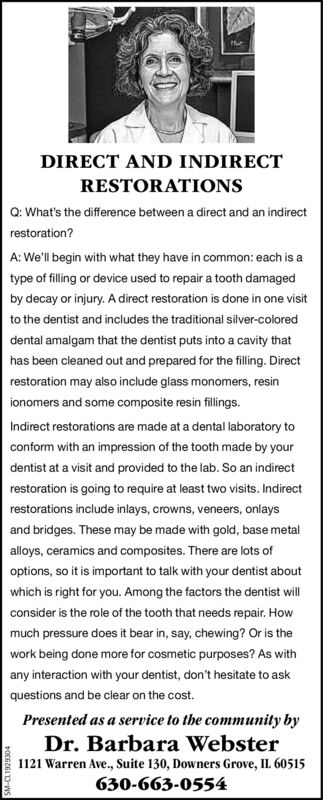Advertisement

-
Published Date
November 4, 2021This ad was originally published on this date and may contain an offer that is no longer valid. To learn more about this business and its most recent offers, click here.
Ad Text
DIRECT AND INDIRECT RESTORATIONS Q: What's the difference between a direct and an indirect restoration? A: We'l begin with what they have in common: each is a type of filling or device used to repair a tooth damaged by decay or injury. A direct restoration is done in one visit to the dentist and includes the traditional silver-colored dental amalgam that the dentist puts into a cavity that has been cleaned out and prepared for the filling. Direct restoration may also include glass monomers, resin ionomers and some composite resin fillings. Indirect restorations are made at a dental laboratory to conform with an impression of the tooth made by your dentist at a visit and provided to the lab. So an indirect restoration is going to require at least two visits. Indirect restorations include inlays, crowns, veneers, onlays and bridges. These may be made with gold, base metal alloys, ceramics and composites. There are lots of options, so it is important to talk with your dentist about which is right for you. Among the factors the dentist will consider is the role of the tooth that needs repair. How much pressure does it bear in, say, chewing? Or is the work being done more for cosmetic purposes? As with any interaction with your dentist, don't hesitate to ask questions and be clear on the cost. Presented as a service to the community by Dr. Barbara Webster 1121 Warren Ave., Suite 130, Downers Grove, IL 60515 630-663-0554 DIRECT AND INDIRECT RESTORATIONS Q: What's the difference between a direct and an indirect restoration? A: We'l begin with what they have in common: each is a type of filling or device used to repair a tooth damaged by decay or injury. A direct restoration is done in one visit to the dentist and includes the traditional silver-colored dental amalgam that the dentist puts into a cavity that has been cleaned out and prepared for the filling. Direct restoration may also include glass monomers, resin ionomers and some composite resin fillings. Indirect restorations are made at a dental laboratory to conform with an impression of the tooth made by your dentist at a visit and provided to the lab. So an indirect restoration is going to require at least two visits. Indirect restorations include inlays, crowns, veneers, onlays and bridges. These may be made with gold, base metal alloys, ceramics and composites. There are lots of options, so it is important to talk with your dentist about which is right for you. Among the factors the dentist will consider is the role of the tooth that needs repair. How much pressure does it bear in, say, chewing? Or is the work being done more for cosmetic purposes? As with any interaction with your dentist, don't hesitate to ask questions and be clear on the cost. Presented as a service to the community by Dr. Barbara Webster 1121 Warren Ave., Suite 130, Downers Grove, IL 60515 630-663-0554
